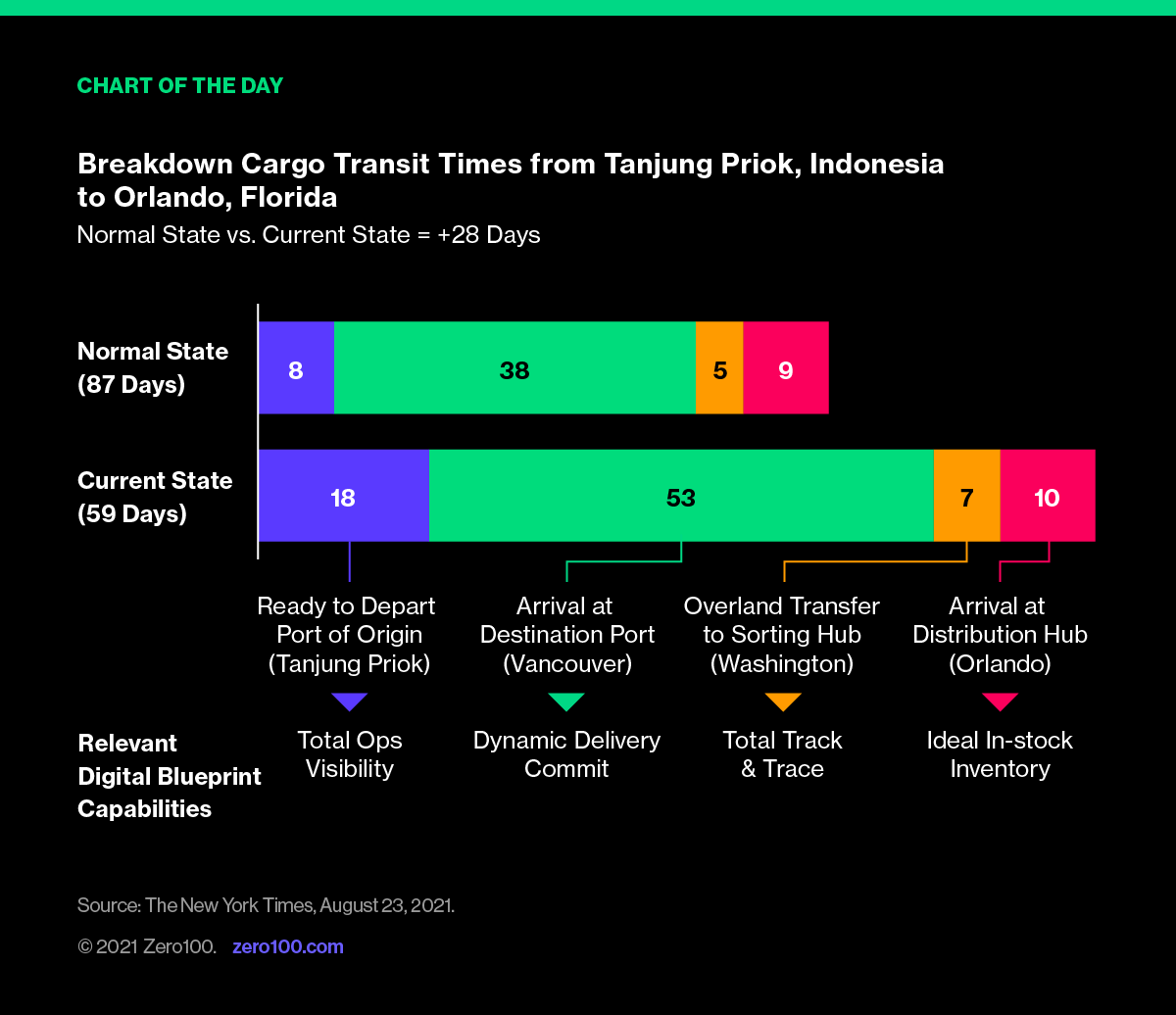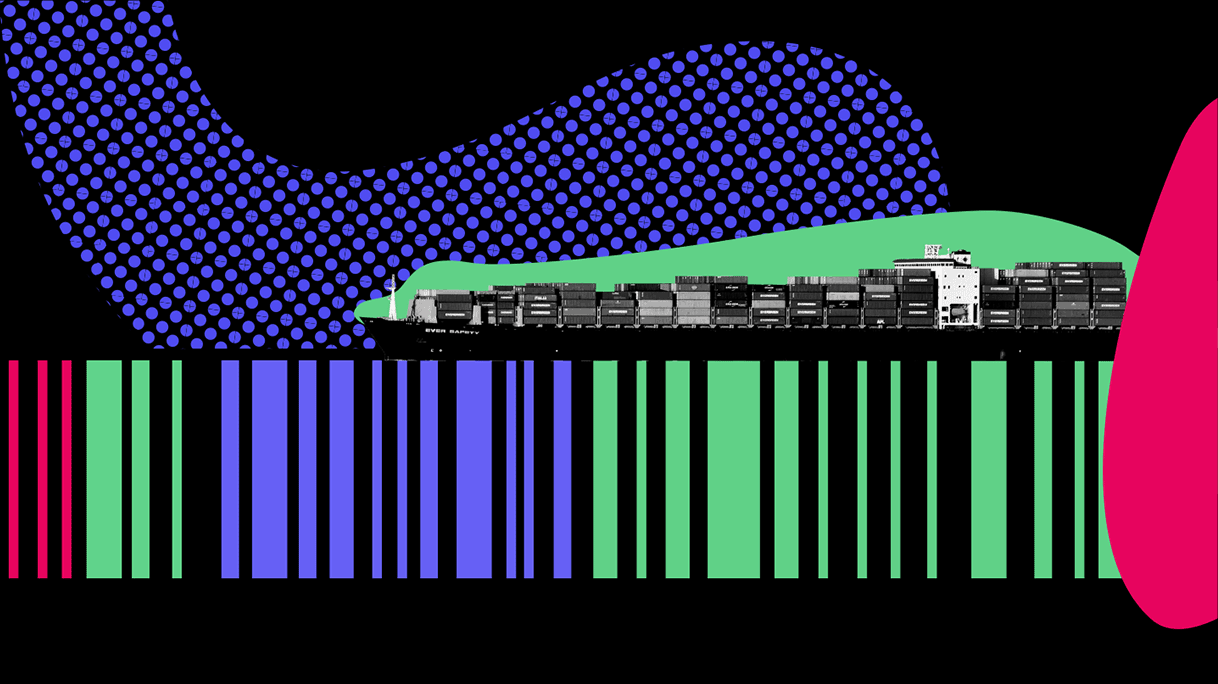As was tragically illustrated across both national news outlets and Last Sunday, as Hurricane Ida made landfall along the Gulf Coast, a 7-foot storm surge caused the flow of the great Mississippi River (the 4th largest river in the world) to briefly REVERSE direction. As was tragically illustrated across both national news outlets and social media feeds, the collateral damage caused by this “extremely uncommon” imbalance in the system can and will have long-lasting effects as measured in displacement, property damage, and human suffering.
Picking up where we left off last week, while the crisis at the Ningbo-Zhoushan Port may have abated, we are just beginning to see the domino effect unfold in Los Angeles/Long Beach (responsible for a third of U.S. imports). At present, a record-breaking 44 ships are parked in a queue off the coast of California, with an average wait time of 7.6 days. The knock-on effects of this traffic jam are hairy: +400% spike in spot prices for freight since 2019, 2x longer transit times form Shanghai to Chicago (up from 35 to 73 days), and a -20% drop-off in contractual commitments by ocean carriers. Long global supply chains are starting to feel a bit like the flooding Mississippi River – flowing backwards.
Reality is parable for the biblical shift supply chains are going through now—we'd better think a lot bigger about what needs to change, starting today.
Hey Noah! Build Me an Ark.
Despite the obvious rumbles of epic change, some seem to believe the old formula of selling cheap stuff made by low paid workers 10,000 miles away is still cool. Michael Witynski CEO of Dollar Tree for instance said: “Industry experts expect the ocean shipping capacity will normalize no later than 2023, when many new ships come online.” And Despite the obvious rumbles of epic change, some seem to believe the old formula of selling cheap stuff made by low paid workers 10,000 miles away is still cool. Michael Witynski CEO of Dollar Tree for instance said: “Industry experts expect the ocean shipping capacity will normalize no later than 2023, when many new ships come online.” And this in an article that blamed the Los Angeles/Long Beach backup on labor shortages and bigger ships: “...ships are double or triple the size of the ships we were seeing 10 or 15 years ago. They take longer to unload. You need more trucks, more trains, more warehouses..." said Kip Louttit (Executive Director, Marine Exchange of Southern California). The message we're supposed to hear is that if we can just survive the next 40 days and nights everything will be okay.
[Rant Alert!!]
Really? Labor is going to be okay with it? Even bigger new ships? Isn't this just a continued bet on more cheap crap from China—all based on underpaid workers, both in the U.S. and in China? Are we really hoping to “normalize” back to that? What about paying people more, pulling the demand rug out from the dollar store sector, and designing new sourcing catchment basins even if that requires different deals on consumer products?
Some are turning the page—and thank goodness for that. Walmart for instance is seeking to hire 20,000 supply chain workers to augment its distribution and fulfillment centers and is investing in serious talent development, including six Walmart Academies that train people on supply chain skills. The average wage for supply chain associates at Walmart is $20.37 per hour, with decent benefits. And don't forget Amazon who pioneered the move upward in pay with its nationwide $15 per hour minimum wage while hiring over 100,000 people during COVID's first surge and offering not only good benefits, but tuition reimbursement. Both, by the way, are still playing catch-up with Costco who has a long track record of being good to employees.
The winners coming out of COVID clearly see the need to do what Henry Ford did 100 years ago with his $5 per day wage—raise the floor for workers, which, stretching my analogy—might keep us dry despite the flood.
A Post Diluvian Supply Chain
Paying more (money, respect, attention) is just one ingredient of post-COVID supply chain strategy. We should also localize supply bases, reducing long lead-time risks and injecting economic juice into our neighborhoods. Digital innovation might be the key to accommodating higher wages in these backyard sourcing adventures. Dynamic Pricing, for instance, promises a new inventory tactic using “characteristic-based” Bill-of-Materials and negotiated consumer pricing to carry less finished goods but more WIP inventory.
Let's get smart and flip the cycle from ever cheaper to ever better.

Critical Reading
THE NEW YORK TIMES
What an Adult Tricycle Says About the World's Bottleneck Problems
Commentary: Best line of the week: “We're sitting on $2M in inventory for one $30 part,” as well as the source of inspiration for our Chart of the Week.
#infographics
FINANCIAL TIMES
Strikes at Korea's Global Shipping Giant Threaten Supply Chain Turmoil
Commentary: Expanded analysis of the labor facet of our discussion this week, tracking a potential crippling walkout at HHM that passed with an 88% vote of organizing longshore workers.
#APAC #logistics
FORBES
The Supply Chain is in Crisis. How Do We Move Forward?
Commentary: Reflecting my own thoughts above, here's another voice (@grocery_nerd) talking solutions to “Just in Time” capitalism, NOT re-stating problems. Preach, brother.
#food&bev
